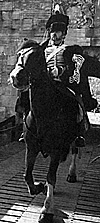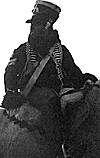Hussars on Campaign
First, a swift run-through of your typical Hussar on campaign. He wears a shako, red in colour, dark blue dolman, cut tight to the body (and cut tight to my body is not pretty, let me assure you!), grey overalls and ankle-length 'george' boots. Over his left (or nearside) shoulder he carries a buff cartouche belt with ammunition pouch and a spring clip 'swivel' to attach his carbine, over his right (or offside), a haversack and canteen, and of course his 1796 pattern sabre slung low on his left. His saddle holds his rolled cloak in front of him with two pistols and holsters underneath it, and a valise behind him housing his personnel kit. A sheepskin covers the saddle and aids comfort . . . about the only thing that does! So, how does all this equipment measure up? In short, what those Osprey books didn't tell you!
What can be said about the heavily braided cavalry dolman? Well when you have done up all 21 buttons, you can often glance down and see a spare button at the bottom, this is usually followed by a frantic fumble at your neck only to find a spare loop . . . mmm, every button is one hole out . . . that's nice. Again, the 80 yards of white lace must have been hell to keep even vaguely clean, I've found the whitener we use for the sabre and cartouche belts handy for touching this up.
Overalls of Grey
My grey overalls are, it has to be said, slightly, err . . . OK, I admit, I take them off and they stand up on their own! The inner leg leather reinforcing stands up to wear and tear quite well, but the knees wear out and so I have curious, Frankenstein-like, stitching on both knees. I suppose I should receive a new pair, as they were a four-year issue item, but as I only wear them 10 to 12 times a year, how must a regularly worn pair have looked? The 'Peacock' image is fading fast. How do you clean them? I dunno, I never have! The 'george' boot has a strange effect in that, no matter how hot a day it is, your toes are freezing! And, in cold weather — Leipzig in November for instance — thick socks will not save you, those toes are numb.
The leather pouch holds 28 cartridges in a drilled wooden block. We drilled ours slightly smaller than the ball calibre of .65ins so that the black powder cartridges are a slight push fit. For two reasons: one being safety, in that it is impossible to carry ball, and the other is that the pouch is a bugger to close in a hurry, halfway up your back. Our modification stops you becoming a 19th-century JP233 runway denial weapon as you gallop away, scattering bomblets behind you!
Lastly, your sabre — the symbol of the cavalryman. It hangs low and menacing, and just the right height to rip and tear the red leg stripe on your overalls. Also you would not believe how a scabbard laying against a horse's sweaty flank for a day will rust. What do these animals sweat? I think it is from horse sweat that Ridley Scott developed the blood for Alien! I got an eyeful once and, well, the vicar won't be visiting again in a hurry. You can see why the scabbards were enamelled black on campaign. The scabbard also has a wooden insert to stop the sabre clanking, but all this seems to do is get wet, swell up and make it a nightmare to draw or return your weapon. We removed our wood, for the above reason, and also, more importantly, because it makes that classic 'sssching' sound as you 'draw swords'. Sad? Us? . . . NAW!!!
Next month I will look at horse tack/furniture and, very importantly, how to sleep in comfort, in a field, with your horse tied to your foot!
This article appears in MagWeb (Magazine Web) on the Internet World Wide Web. I have been re-enacting in the 15th (or Kings) Light Dragoon (Hussars) for about four years now and have taken part in many displays, battles and campaign/marches across Europe. I have seen many cultures and met many varied and interesting people – a good 50 per cent of whom I have tried to sabre! This is not, however, an advert for the Napoleonic Association, fine fellows that they are, but an attempt to explain and/or query some facts about historical equipment, used constantly in all manner of literature and accepted as accurate until you try to put them into practice on a horse! In this article I shall explain how I have modified various items of kit and some observations on others that change from 'useful and practical' on the printed page to 'useless and painful' on the sweaty nag!
I have been re-enacting in the 15th (or Kings) Light Dragoon (Hussars) for about four years now and have taken part in many displays, battles and campaign/marches across Europe. I have seen many cultures and met many varied and interesting people – a good 50 per cent of whom I have tried to sabre! This is not, however, an advert for the Napoleonic Association, fine fellows that they are, but an attempt to explain and/or query some facts about historical equipment, used constantly in all manner of literature and accepted as accurate until you try to put them into practice on a horse! In this article I shall explain how I have modified various items of kit and some observations on others that change from 'useful and practical' on the printed page to 'useless and painful' on the sweaty nag!
 The shako, made up of paste board, felt, and leather must have been a wretched thing to keep clean and correctly shaped, and an oilskin cover is a must for campaign. We tend to keep the plume in a thin card tube lying on top of the shako with the cords likewise under the cover. As any re-enactor will tell you, anything less than 10ft square will go missing in about — ooooh — five minutes. The cover doesn't extend to the leather peak though and, when wet, this can curl up until you look like a sodden Daffy Duck! This is, however, offset by the glorious fact that two cans of best bitter will easily fit inside it, unnoticed by the Troop Sergeant!
The shako, made up of paste board, felt, and leather must have been a wretched thing to keep clean and correctly shaped, and an oilskin cover is a must for campaign. We tend to keep the plume in a thin card tube lying on top of the shako with the cords likewise under the cover. As any re-enactor will tell you, anything less than 10ft square will go missing in about — ooooh — five minutes. The cover doesn't extend to the leather peak though and, when wet, this can curl up until you look like a sodden Daffy Duck! This is, however, offset by the glorious fact that two cans of best bitter will easily fit inside it, unnoticed by the Troop Sergeant!
 The canteen is wood. It leaks. Nuff said. The haversack carries your horse-grooming kit, plate, spoon, mug and anything you can forage. Incidentally, being on a horse means that you can 'scrump' a better class of tree-bound fruit than your foot-slogging counterparts.
The canteen is wood. It leaks. Nuff said. The haversack carries your horse-grooming kit, plate, spoon, mug and anything you can forage. Incidentally, being on a horse means that you can 'scrump' a better class of tree-bound fruit than your foot-slogging counterparts.
Back to Table of Contents -- First Empire #34
© Copyright 1997 by First Empire.
Other military history articles and gaming articles are available at http://www.magweb.com